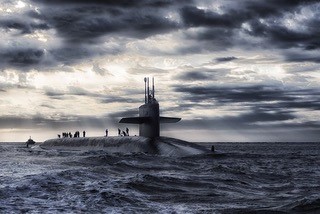We are engaged in a war of algorithms; a battle fought in cyber space that also plays out across air, land, and sea every day. Digital transformation is the key to winning because it gives us a critical advantage: the ability to execute before the adversary can.

This “decision advantage” comes, in part, from embedding technology into the mission at the service of the warfighter. Technology transformation at the kinetic level, for example, makes efforts at the tip of the spear more successful. Imagine real-time AI-processed reconnaissance information optimizing ordinance activity on-target. Or turning our ships at sea into floating data centers: optimizing communication, battlefield insights, ship defenses, onboard maintenance, and medical care for our wounded warriors.
Today, across the department and in all branches of the U.S. military, IT leaders are looking for solutions to turn their legacy IT footprint into a modern multi-cloud environment. This transformation will also bring sweeping changes to our workforce. Tomorrow’s pilot will need to be as good at multi-mode IT systems management as actually flying an aircraft.
Technology transformation with the Department of Defense (DoD) means looking at where computer activity needs to take place. This could include activity in a data center, or on a sensor, drone, mobile device, aircraft, and even an office-based workstation. Where this processing activity, called a ‘workload’ takes place should be optimized for the mission – and not optimized for the convenience of the IT purchasing process. Mission-optimized IT includes Domestic DOD-managed cloud environments and data centers, ad hoc IT networks in forward operating positions with disadvantaged communication, or on the battlefield itself.
In support of this transformation, a multi-cloud approach allows the military to deploy infrastructure that is secure and flexible for mission-critical projects. One such example is a recent Defense Department effort to build out a secure, on-premise cloud solution within its existing data center footprint. Outdated and unsupported legacy IT systems were eating up already-scarce funding and leaving our warfighters and their mission exposed to the adversary.
Dell EMC is honored to have partnered with DoD in this effort, known as the On-Site Managed Services (OMS) program. It provides high-availability, high-performance, mission-critical compute services. This cutting-edge IT transformation program allows the DoD to manage their most sensitive workloads and provide compute and processing wherever the mission requires.
OMS illustrates the point that mission success is all about operation and accessibility, requiring different approaches for each unique workload. With a complex map of challenges and mission-critical considerations, the DoD must continue to approach cloud on a workload-by-workload basis for IT modernization success, appreciating cloud as an operating model.
If you want to learn more about how OMS can drive DoD IT transformation, visit: https://www.smartronix.com/services/Cloud-Computing/Pages/On-Site-Managed-Services-(OMS).html
